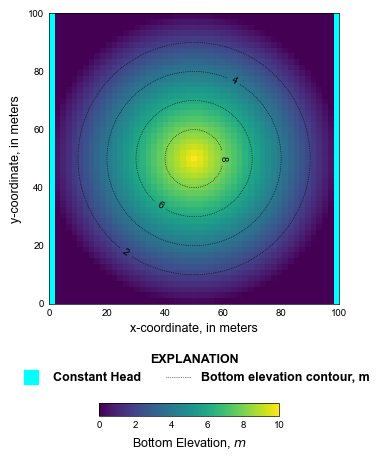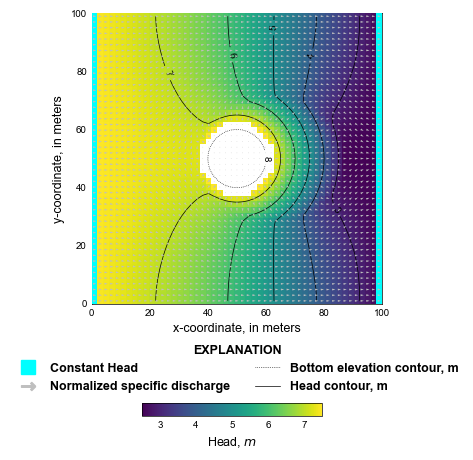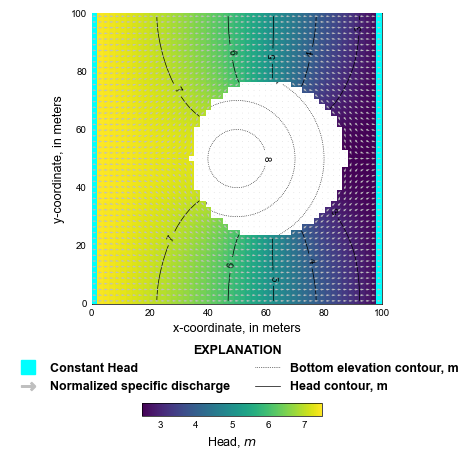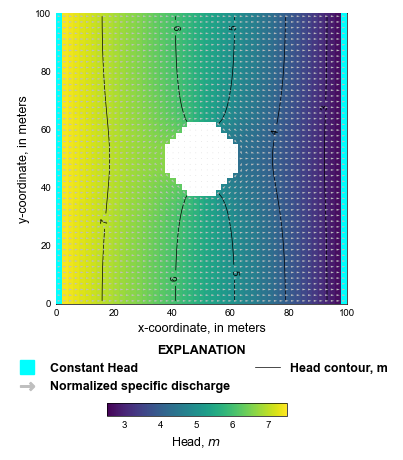Flow diversion example
This example simulates unconfined groundwater flow in an aquifer with a high bottom elevation in the center of the aquifer and groundwater flow around a high bottom elevation.
Initial setup
Import dependencies, define the example name and workspace, and read settings from environment variables.
[1]:
import os
import pathlib as pl
import flopy
import git
import matplotlib as mpl
import matplotlib.pyplot as plt
import numpy as np
import pooch
from flopy.plot.styles import styles
from modflow_devtools.misc import get_env, timed
# Example name and workspace paths. If this example is running
# in the git repository, use the folder structure described in
# the README. Otherwise just use the current working directory.
sim_name = "ex-gwf-bump"
try:
root = pl.Path(git.Repo(".", search_parent_directories=True).working_dir)
except:
root = None
workspace = root / "examples" if root else pl.Path.cwd()
figs_path = root / "figures" if root else pl.Path.cwd()
data_path = root / "data" / sim_name if root else pl.Path.cwd()
# Settings from environment variables
write = get_env("WRITE", True)
run = get_env("RUN", True)
plot = get_env("PLOT", True)
plot_show = get_env("PLOT_SHOW", True)
plot_save = get_env("PLOT_SAVE", True)
Define parameters
Define model units, parameters and other settings.
[2]:
# Model units
length_units = "meters"
time_units = "days"
# Scenario-specific parameters
parameters = {
"ex-gwf-bump-p01a": {
"newton": "newton",
},
"ex-gwf-bump-p01b": {
"rewet": True,
"wetfct": 1.0,
"iwetit": 1,
"ihdwet": 0,
"wetdry": 2.0,
},
"ex-gwf-bump-p01c": {
"newton": "newton",
"cylindrical": True,
},
}
# Model parameters
nper = 1 # Number of periods
nlay = 1 # Number of layers
nrow = 51 # Number of rows
ncol = 51 # Number of columns
xlen = 100.0 # Model length in x-direction ($m$)
ylen = 100.0 # Model length in y-direction ($m$)
top = 25.0 # Top of the model ($m$)
k11 = 1.0 # Horizontal hydraulic conductivity ($m/day$)
H1 = 7.5 # Constant head in column 1 and starting head ($m$)
H2 = 2.5 # Constant head in column 51 ($m$)
# Time discretization
tdis_ds = ((1.0, 1, 1.0),)
# Calculate delr, delc, extents, and shape3d
delr = xlen / float(ncol)
delc = ylen / float(nrow)
extents = (0, xlen, 0, ylen)
shape3d = (nlay, nrow, ncol)
# Load the bottom
fname = "bottom.txt"
fpath = pooch.retrieve(
url=f"https://github.com/MODFLOW-USGS/modflow6-examples/raw/master/data/{sim_name}/{fname}",
fname=fname,
path=data_path,
known_hash="md5:9287f9e214147d95e6ed159732079a0b",
)
botm = np.loadtxt(fpath).reshape(shape3d)
# Create a cylinder
cylinder = botm.copy()
cylinder[cylinder < 7.5] = 0.0
cylinder[cylinder >= 7.5] = 20.0
# Constant head boundary conditions
chd_spd = [[0, i, 0, H1] for i in range(nrow)]
chd_spd += [[0, i, ncol - 1, H2] for i in range(nrow)]
# Solver parameters
nouter = 500
ninner = 500
hclose = 1e-9
rclose = 1e-6
Model setup
Define functions to build models, write input files, and run the simulation.
[3]:
def build_models(
name,
newton=False,
rewet=False,
cylindrical=False,
wetfct=None,
iwetit=None,
ihdwet=None,
wetdry=None,
):
sim_ws = os.path.join(workspace, name)
sim = flopy.mf6.MFSimulation(sim_name=sim_name, sim_ws=sim_ws, exe_name="mf6")
flopy.mf6.ModflowTdis(sim, nper=nper, perioddata=tdis_ds, time_units=time_units)
if newton:
linear_acceleration = "bicgstab"
newtonoptions = "newton under_relaxation"
else:
linear_acceleration = "cg"
newtonoptions = None
flopy.mf6.ModflowIms(
sim,
print_option="ALL",
linear_acceleration=linear_acceleration,
outer_maximum=nouter,
outer_dvclose=hclose,
inner_maximum=ninner,
inner_dvclose=hclose,
rcloserecord=rclose,
)
gwf = flopy.mf6.ModflowGwf(
sim,
modelname=sim_name,
newtonoptions=newtonoptions,
save_flows=True,
)
if cylindrical:
bot = cylinder
else:
bot = botm
flopy.mf6.ModflowGwfdis(
gwf,
length_units=length_units,
nlay=nlay,
nrow=nrow,
ncol=ncol,
delr=delr,
delc=delc,
top=top,
botm=bot,
)
if rewet:
rewet_record = [
"wetfct",
wetfct,
"iwetit",
iwetit,
"ihdwet",
ihdwet,
]
else:
rewet_record = None
flopy.mf6.ModflowGwfnpf(
gwf,
rewet_record=rewet_record,
icelltype=1,
k=k11,
wetdry=wetdry,
save_specific_discharge=True,
)
flopy.mf6.ModflowGwfic(gwf, strt=H1)
flopy.mf6.ModflowGwfchd(gwf, stress_period_data=chd_spd)
head_filerecord = f"{sim_name}.hds"
budget_filerecord = f"{sim_name}.cbc"
flopy.mf6.ModflowGwfoc(
gwf,
head_filerecord=head_filerecord,
budget_filerecord=budget_filerecord,
saverecord=[("HEAD", "ALL"), ("BUDGET", "ALL")],
)
return sim
def write_models(sim, silent=True):
sim.write_simulation(silent=silent)
@timed
def run_models(sim, silent=True):
success, buff = sim.run_simulation(silent=silent)
assert success, buff
Plotting results
Define functions to plot model results.
[4]:
# Figure properties, plotting ranges and contour levels
figure_size = (4, 5.33)
masked_values = (1e30, -1e30)
vmin, vmax = H2, H1
bmin, bmax = 0, 10
vlevels = np.arange(vmin + 0.5, vmax, 1)
blevels = np.arange(bmin + 2, bmax, 2)
bcolor = "black"
vcolor = "black"
def create_figure():
fig = plt.figure(figsize=figure_size, constrained_layout=False)
gs = mpl.gridspec.GridSpec(ncols=10, nrows=7, figure=fig, wspace=5)
plt.axis("off")
# create axes
ax1 = fig.add_subplot(gs[:5, :])
ax2 = fig.add_subplot(gs[5:, :])
# set limits for map figure
ax1.set_xlim(extents[:2])
ax1.set_ylim(extents[2:])
ax1.set_aspect("equal")
# set limits for legend area
ax2.set_xlim(0, 1)
ax2.set_ylim(0, 1)
# get rid of ticks and spines for legend area
ax2.axis("off")
ax2.set_xticks([])
ax2.set_yticks([])
ax2.spines["top"].set_color("none")
ax2.spines["bottom"].set_color("none")
ax2.spines["left"].set_color("none")
ax2.spines["right"].set_color("none")
ax2.patch.set_alpha(0.0)
axes = [ax1, ax2]
return fig, axes
def plot_grid(gwf, silent=True):
with styles.USGSMap() as fs:
bot = gwf.dis.botm.array
fig, axes = create_figure()
ax = axes[0]
mm = flopy.plot.PlotMapView(gwf, ax=ax, extent=extents)
bot_coll = mm.plot_array(bot, vmin=bmin, vmax=bmax)
mm.plot_bc("CHD", color="cyan")
cv = mm.contour_array(
bot,
levels=blevels,
linewidths=0.5,
linestyles=":",
colors=bcolor,
)
plt.clabel(cv, fmt="%1.0f")
ax.set_xlabel("x-coordinate, in meters")
ax.set_ylabel("y-coordinate, in meters")
styles.remove_edge_ticks(ax)
# legend
ax = axes[1]
ax.plot(
-10000,
-10000,
lw=0,
marker="s",
ms=10,
mfc="cyan",
mec="cyan",
label="Constant Head",
)
ax.plot(
-10000,
-10000,
lw=0.5,
ls=":",
color=bcolor,
label="Bottom elevation contour, m",
)
styles.graph_legend(ax, loc="center", ncol=2)
cax = plt.axes([0.275, 0.125, 0.45, 0.025])
cbar = plt.colorbar(
bot_coll,
shrink=0.8,
orientation="horizontal",
cax=cax,
)
cbar.ax.tick_params(size=0)
cbar.ax.set_xlabel(r"Bottom Elevation, $m$")
if plot_show:
plt.show()
if plot_save:
fpth = figs_path / f"{sim_name}-grid.png"
fig.savefig(fpth)
def plot_results(idx, sim, silent=True):
with styles.USGSMap():
gwf = sim.get_model(sim_name)
bot = gwf.dis.botm.array
if idx == 0:
plot_grid(gwf, silent=silent)
# create MODFLOW 6 head object
hobj = gwf.output.head()
# create MODFLOW 6 cell-by-cell budget object
cobj = gwf.output.budget()
# extract heads and specific discharge
head = hobj.get_data(totim=1.0)
imask = (head > -1e30) & (head <= bot)
head[imask] = -1e30 # botm[imask]
qx, qy, qz = flopy.utils.postprocessing.get_specific_discharge(
cobj.get_data(text="DATA-SPDIS", totim=1.0)[0],
gwf,
)
# Create figure for simulation
fig, axes = create_figure()
ax = axes[0]
mm = flopy.plot.PlotMapView(gwf, ax=ax, extent=extents)
if bot.max() < 20:
cv = mm.contour_array(
bot,
levels=blevels,
linewidths=0.5,
linestyles=":",
colors=bcolor,
zorder=9,
)
plt.clabel(cv, fmt="%1.0f", zorder=9)
h_coll = mm.plot_array(
head, vmin=vmin, vmax=vmax, masked_values=masked_values, zorder=10
)
cv = mm.contour_array(
head,
masked_values=masked_values,
levels=vlevels,
linewidths=0.5,
linestyles="-",
colors=vcolor,
zorder=10,
)
plt.clabel(cv, fmt="%1.0f", zorder=10)
mm.plot_bc("CHD", color="cyan", zorder=11)
mm.plot_vector(qx, qy, normalize=True, color="0.75", zorder=11)
ax.set_xlabel("x-coordinate, in meters")
ax.set_ylabel("y-coordinate, in meters")
styles.remove_edge_ticks(ax)
# create legend
ax = axes[-1]
ax.plot(
-10000,
-10000,
lw=0,
marker="s",
ms=10,
mfc="cyan",
mec="cyan",
label="Constant Head",
)
ax.plot(
-10000,
-10000,
lw=0,
marker="$\u2192$",
ms=10,
mfc="0.75",
mec="0.75",
label="Normalized specific discharge",
)
if bot.max() < 20:
ax.plot(
-10000,
-10000,
lw=0.5,
ls=":",
color=bcolor,
label="Bottom elevation contour, m",
)
ax.plot(
-10000,
-10000,
lw=0.5,
ls="-",
color=vcolor,
label="Head contour, m",
)
styles.graph_legend(ax, loc="center", ncol=2)
cax = plt.axes([0.275, 0.125, 0.45, 0.025])
cbar = plt.colorbar(h_coll, shrink=0.8, orientation="horizontal", cax=cax)
cbar.ax.tick_params(size=0)
cbar.ax.set_xlabel(r"Head, $m$", fontsize=9)
if plot_show:
plt.show()
if plot_save:
fig.savefig(figs_path / f"{sim_name}-{idx + 1:02d}.png")
Running the example
Define a function to run the example scenarios and plot results.
[5]:
def scenario(idx, silent=True):
key = list(parameters.keys())[idx]
params = parameters[key].copy()
sim = build_models(key, **params)
if write:
write_models(sim, silent=silent)
if run:
run_models(sim, silent=silent)
if plot:
plot_results(idx, sim, silent=silent)
Run the flow diversion model with Newton-Raphson and plot simulated heads.
[6]:
scenario(0, silent=False)
writing simulation...
writing simulation name file...
writing simulation tdis package...
writing solution package ims_-1...
writing model ex-gwf-bump...
writing model name file...
writing package dis...
writing package npf...
writing package ic...
writing package chd_0...
INFORMATION: maxbound in ('gwf6', 'chd', 'dimensions') changed to 102 based on size of stress_period_data
writing package oc...
FloPy is using the following executable to run the model: ../../../../../.local/bin/modflow/mf6
MODFLOW 6
U.S. GEOLOGICAL SURVEY MODULAR HYDROLOGIC MODEL
VERSION 6.5.0.dev2 (preliminary) 04/23/2024
***DEVELOP MODE***
MODFLOW 6 compiled Apr 23 2024 02:35:18 with Intel(R) Fortran Intel(R) 64
Compiler Classic for applications running on Intel(R) 64, Version 2021.7.0
Build 20220726_000000
This software is preliminary or provisional and is subject to
revision. It is being provided to meet the need for timely best
science. The software has not received final approval by the U.S.
Geological Survey (USGS). No warranty, expressed or implied, is made
by the USGS or the U.S. Government as to the functionality of the
software and related material nor shall the fact of release
constitute any such warranty. The software is provided on the
condition that neither the USGS nor the U.S. Government shall be held
liable for any damages resulting from the authorized or unauthorized
use of the software.
MODFLOW runs in SEQUENTIAL mode
Run start date and time (yyyy/mm/dd hh:mm:ss): 2024/04/24 13:42:57
Writing simulation list file: mfsim.lst
Using Simulation name file: mfsim.nam
Solving: Stress period: 1 Time step: 1
Run end date and time (yyyy/mm/dd hh:mm:ss): 2024/04/24 13:42:57
Elapsed run time: 0.213 Seconds
Normal termination of simulation.
run_models took 222.96 ms


Run the flow diversion model with rewetting and plot simulated heads.
[7]:
scenario(1, silent=False)
writing simulation...
writing simulation name file...
writing simulation tdis package...
writing solution package ims_-1...
writing model ex-gwf-bump...
writing model name file...
writing package dis...
writing package npf...
writing package ic...
writing package chd_0...
INFORMATION: maxbound in ('gwf6', 'chd', 'dimensions') changed to 102 based on size of stress_period_data
writing package oc...
FloPy is using the following executable to run the model: ../../../../../.local/bin/modflow/mf6
MODFLOW 6
U.S. GEOLOGICAL SURVEY MODULAR HYDROLOGIC MODEL
VERSION 6.5.0.dev2 (preliminary) 04/23/2024
***DEVELOP MODE***
MODFLOW 6 compiled Apr 23 2024 02:35:18 with Intel(R) Fortran Intel(R) 64
Compiler Classic for applications running on Intel(R) 64, Version 2021.7.0
Build 20220726_000000
This software is preliminary or provisional and is subject to
revision. It is being provided to meet the need for timely best
science. The software has not received final approval by the U.S.
Geological Survey (USGS). No warranty, expressed or implied, is made
by the USGS or the U.S. Government as to the functionality of the
software and related material nor shall the fact of release
constitute any such warranty. The software is provided on the
condition that neither the USGS nor the U.S. Government shall be held
liable for any damages resulting from the authorized or unauthorized
use of the software.
MODFLOW runs in SEQUENTIAL mode
Run start date and time (yyyy/mm/dd hh:mm:ss): 2024/04/24 13:42:58
Writing simulation list file: mfsim.lst
Using Simulation name file: mfsim.nam
Solving: Stress period: 1 Time step: 1
Run end date and time (yyyy/mm/dd hh:mm:ss): 2024/04/24 13:42:58
Elapsed run time: 0.109 Seconds
Normal termination of simulation.
run_models took 122.20 ms

Run the flow diversion model with Newton-Raphson and cylindrical topography and plot simulated heads.
[8]:
scenario(2, silent=False)
writing simulation...
writing simulation name file...
writing simulation tdis package...
writing solution package ims_-1...
writing model ex-gwf-bump...
writing model name file...
writing package dis...
writing package npf...
writing package ic...
writing package chd_0...
INFORMATION: maxbound in ('gwf6', 'chd', 'dimensions') changed to 102 based on size of stress_period_data
writing package oc...
FloPy is using the following executable to run the model: ../../../../../.local/bin/modflow/mf6
MODFLOW 6
U.S. GEOLOGICAL SURVEY MODULAR HYDROLOGIC MODEL
VERSION 6.5.0.dev2 (preliminary) 04/23/2024
***DEVELOP MODE***
MODFLOW 6 compiled Apr 23 2024 02:35:18 with Intel(R) Fortran Intel(R) 64
Compiler Classic for applications running on Intel(R) 64, Version 2021.7.0
Build 20220726_000000
This software is preliminary or provisional and is subject to
revision. It is being provided to meet the need for timely best
science. The software has not received final approval by the U.S.
Geological Survey (USGS). No warranty, expressed or implied, is made
by the USGS or the U.S. Government as to the functionality of the
software and related material nor shall the fact of release
constitute any such warranty. The software is provided on the
condition that neither the USGS nor the U.S. Government shall be held
liable for any damages resulting from the authorized or unauthorized
use of the software.
MODFLOW runs in SEQUENTIAL mode
Run start date and time (yyyy/mm/dd hh:mm:ss): 2024/04/24 13:42:59
Writing simulation list file: mfsim.lst
Using Simulation name file: mfsim.nam
Solving: Stress period: 1 Time step: 1
Run end date and time (yyyy/mm/dd hh:mm:ss): 2024/04/24 13:42:59
Elapsed run time: 0.084 Seconds
Normal termination of simulation.
run_models took 96.26 ms
